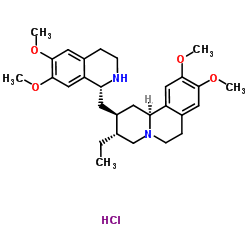Home
Products
Emetine Hydrochloride



| Product Name | Emetine Hydrochloride |
| Price: | Inquiry |
| Catalog No.: | CN01332 |
| CAS No.: | 14198-59-5 |
| Molecular Formula: | C29H41ClN2O4 |
| Molecular Weight: | 517.1 g/mol |
| Purity: | >=98% |
| Type of Compound: | Alkaloids |
| Physical Desc.: | Powder |
| Source: | The roots of Alangium chinense (Lour.) Harms |
| Solvent: | Chloroform, Dichloromethane, Ethyl Acetate, DMSO, Acetone, etc. |
| SMILES: |
| Contact us | |
|---|---|
| First Name: | |
| Last Name: | |
| E-mail: | |
| Question: | |
| Description | Emetine hydrochloride, derived from the ipecac root, is a potent anti-protozoal and emetic agent. Emetine hydrochloride inhibits viral polymerases and inhibits Zika and Ebola virus infections. Emetine hydrochloride potently inhibits autophagy and has anti-malarial, anti-bacterial and anti-amoebic effect[1][2][3][4]. |
| In Vitro | Emetine hydrochloride accumulates SQSTM1 and MAP1LC3B in SNB-19 cells, indicating autophagy is blocked[1]. Emetine hydrochloride dose-dependently decreases NS1 protein level in HEK293 cells infected with the African prototype, ZIKV MR766 (IC50=52.9 nM). Emetine hydrochloride directly inhibits ZIKV NS5 RNA polymerase activity with an IC50 of 121 nM[1]. Cell Autophagy Assay[1] Cell Line: SNB-19 cells Concentration: 25, 50, 100, 200 nM Incubation Time: For 24 hours Result: Showed the accumulation of SQSTM1 and MAP1LC3B, indicating autophagy was blocked. |
| In Vivo | Emetine hydrochloride (1, 2 mg/kg/day; IP; for 3 days) significantly reduces the serum viral load of ZIKV infected Ifnar1−/− mice[1]. Emetine hydrochloride (1 mg/kg/day; retro-orbital injection; for six days) reduces the levels of circulating ZIKV approximately 10-fold in three-month-old female SJL mice with ZIKVBR[1]. Emetine (0.002, 0.02, 0.2, 2 mg/kg/day; i.p.) not only attenuates blood glucose levels in dose-dependent way but also induces a persistent attenuation of blood glucose levels in C57Bl/6 male mice (20-25 g) [2]. Animal Model: Ifnar1−/− mice[1] Dosage: 1, 2 mg/kg Administration: IP; once daily for 3 days Result: Significantly reduced the serum viral load of ZIKV infected Ifnar1−/− mice. |
| Density | 1.17g/cm3 |
| Boiling Point | 624.8ºC at 760 mmHg |
| Flash Point | 331.7ºC |
| Exact Mass | 516.275513 |
| PSA | 52.19000 |
| LogP | 6.01210 |
| Vapour Pressure | 4.54E-16mmHg at 25°C |